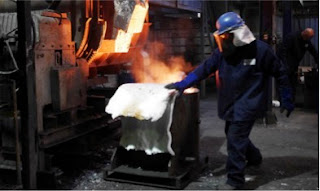Faye Claridge continues to blog about her artist's residency for Shifting Worlds at Ironbridge Gorge Museum with Meadow Arts
 "A lot of
what I’m looking at in the residency involves the role of women in the Darby
family and, therefore, in Quakerism, early education, the iron business and,
ultimately, in the Industrial Revolution.
"A lot of
what I’m looking at in the residency involves the role of women in the Darby
family and, therefore, in Quakerism, early education, the iron business and,
ultimately, in the Industrial Revolution.
The mothers,
wives and sisters in the Darby family were at times shareholders and managers
of the works. Diaries show us they were a regular sight in the works,
understood the business and are recorded as joint signatories on loans and
other business deals. This was in the 18th and 19th
centuries, years before the wider British fight for (a semblance of) equality. In
fact more than 250 years ago there were more women at management level in
Coalbrookdale than there are today. Their achievements are extraordinary and
can only be understood in the context of the Quaker faith.
As
biographer Rachel Labouchere writes: “Quaker women, often with large families,
[who travelled]… many thousands of miles away from their husbands and children,
always seemed to astonish the world at large, but was accepted in their
community and fully understood.” [i]
From the
beginnings in the 1650s Quakers (originally called Seekers) believed women were
equal in faith and were supported in public speaking and publishing. The Darby
women who became ministers travelled extensively to speak at Meetings and either
took nursing babies with them or left them behind (with family or staff) for weeks
or even months at a time. Their long journeys on horseback were also often
undertaken without a male companion.
The Darby
women’s involvement in the business largely occurred after a male death and
before a male heir was old enough to take over, but even so their involvement
wasn’t limited to a caretaker role and some of the developments of workers’
cottages, banking and the brickworks were theirs. I think I’m right in saying
it was their ability to take over that maintained the business in the family,
as without them at worst the death of the head of the family would have meant
selling the business, or at least the balance of ownership would have gone to
other partners.
Their
abilities had, of course, been developed through education as well as inclusion
in business meetings and visits to the works. Again, years ahead of schools for
the general public, Quakers supported education of boys and girls and the Darby
children were all sent to Friends in what we would now understand as boarding
school. By 1718 Abraham Darby II had started building schools for workers’
children and more than a century later, in 1846, Alfred Darby built a very
large school with full support and donations from workers, to educate 700
children up to the age of 12.[ii]
The role of
the male Darbys as fathers is also touched upon in the Darby diaries, where one
notable letter from Abraham Darby to a business associate in 1758 states he
might delay their meeting because he wants to be with the children at the time
of their (then potentially harmful) smallpox vaccination[iii].
He also almost single-handedly brought up his daughter Hannah after the death
of his first wife and the two were very close.
I don’t
expect all of this to come across in the work I’m creating, but it’s been
interesting to talk to visitors about why I’m embroidering names (or asking
them to). Embroidery is a very accessible way into this important story.
Visitors will look at the samplers in the collection and, hopefully after
meeting me, will see them not just as remarkable works of skill but as symbols
of education, empowerment and the joining of domestic and industrial talents."
Shifting Worlds: contemporary art and the Birthplace of Industry is a contemporary art programme produced in a partnership between Meadow Arts and the Ironbridge Gorge Museum Trust, funded by Arts Council England.
All exhibited work and events take place at Coalbrookdale, the site of three of the ten exciting and varied museums that make up the Ironbridge Gorge Museums.
The museums give a fascinating insight into the people, processes and
landscape of the Industrial Revolution and its impact on the present
day.














